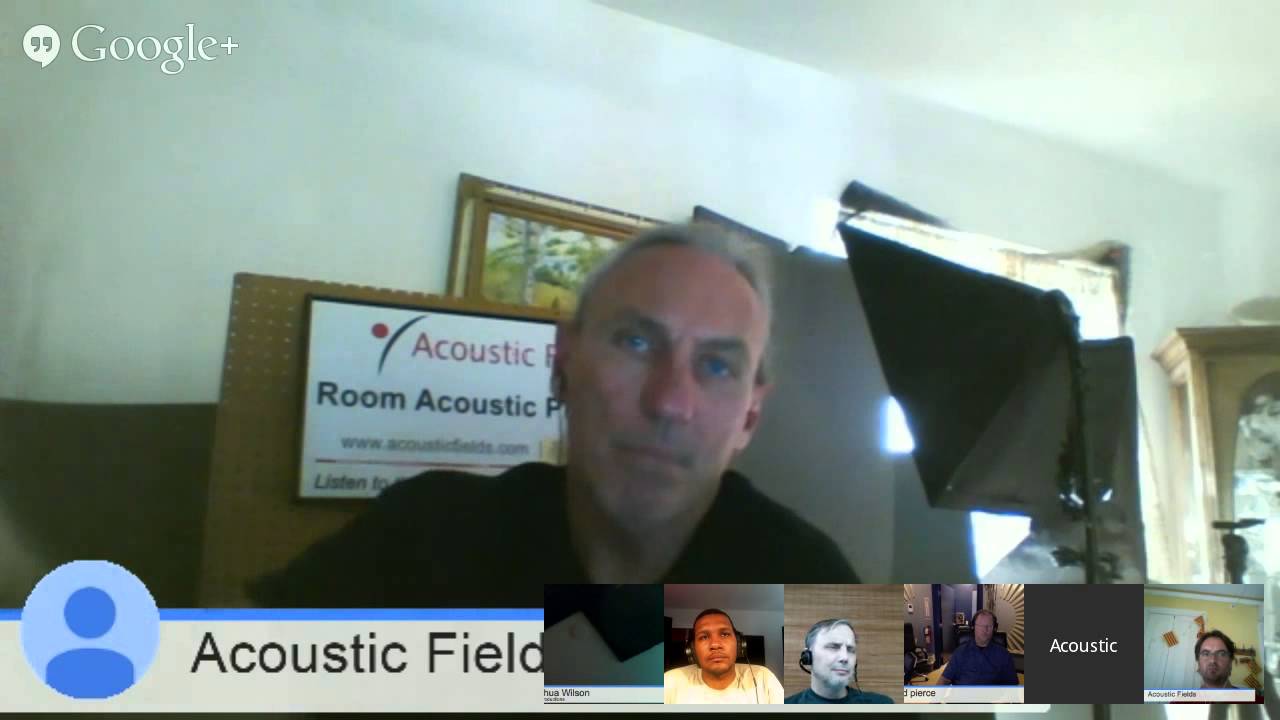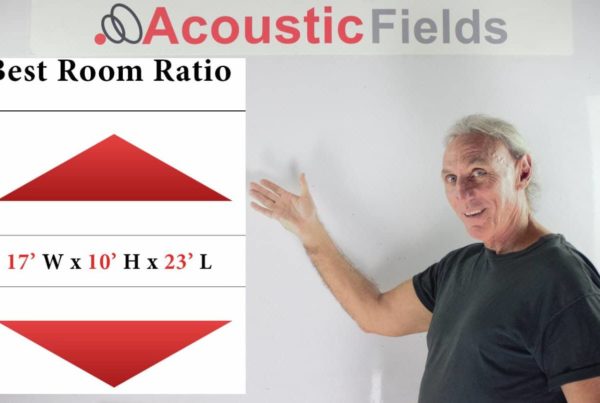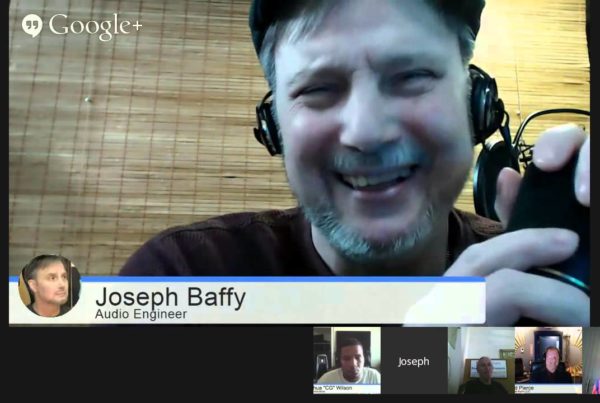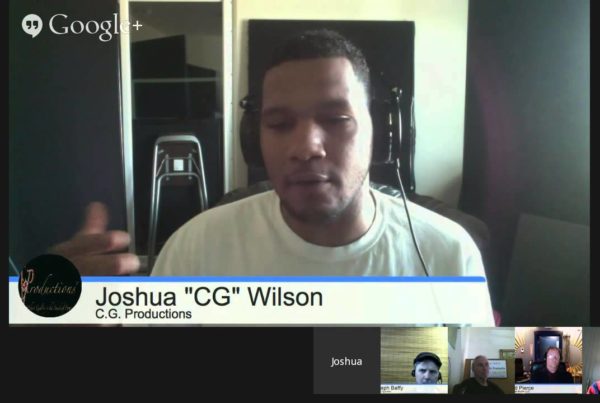In a recent Google Hangout I got together a bunch of experienced and talented audio engineers to help bridge the gap between what you are hearing as an engineer and how the room is causing that problem. We tried to cut through some of the confusion between “mix sound” and “room sound”. The following video and transcript comes from one particular section where we addressed the question “What’s The Best Way To Determine What The Deficiencies In Your Room?”. If you would like to see the full hour and a half discussion you can see the video further down the page.
Joseph Baffy (JB): What’s the best way for a guy who is relatively experienced to determine what the deficiencies in his room are?
Joshua Wilson (JW): Well you’re going to do that once you make your first mix.
Brad Pierce (BP): On a technical level Joseph or are you saying more of a…
JB: No on a technical level. You know let’s just say I’ve reached that growth stage. You know where I’ve grown out of the workarounds and I don’t want go out to the car anymore at this time and I like that. So let’s just say we’re at that growth level and now I want to be able to provide Dennis with something that he can, something tangible, that he can use to help me with my room. What am I going to do?
BP: Have you tried a program called ‘Room EQ Wizard’?
JB: Well I’ll say yes I have but let’s say that I haven’t and then you can explain it to me. You understand where I’m going with this?
BP: Yeah I gotcha.
JW: Well I think the thing is with Dennis is that he’s done this for so long that you can explain to him what it is that you feel and are hearing and he can give you some solutions to that. I think Dennis is pretty much on the ball enough to be able to pick-out things like that. So because he has his database with the room sizes anyway, he’s always going to know what problems in your room is before you actually even tell him so.
Dennis Foley (DF): I think two things we can do here to help the new guy out. Your room has a signature, you as an engineer have a signature sound. You have to know what your room sound is because your room sound and your sound as an engineer, you guys are married. You’re married to your gear, you’re married to your room and you’re married to your sound as an engineer.
So you’ve got three people in this marriage and we all know that two is hard enough to get along with. Now we got a third one in the deal. Alright so how do we, we know ourselves, we know what our signature sound is or what we’re trying to achieve but I think the missing ingredient here is the room sound. We don’t quite know that yet, so we have to figure out that sound. How do we do that? First, we take a picture of the room sound.
How do we do that? We measure its frequency response and we take that and we put it up in front of us. I think if we have that visual reference of our room frequency response and EQ wizard is a good free software that will help you do that. So you take a picture of the room sound and I think if you put that up on your desk that will help you understand what your room sounds like.
The next most important thing to do is sweep the room for two reasons. One, you want to know if there’s any vibrations in the room at certain frequencies because light fixtures vibrate, walls vibrate, everything moves and anything that moves causes sound aberration so we have to be really careful. So first I always do a sweep in the room to see if anything is rattling or shaking or moving and then walk around the room and find the pressure areas, put a little piece of tape where the pressure areas are. Those are the areas that need to be treated, you don’t even need an SBL meter.
When I walk into a room I can almost tell you just sitting in the listening chair where the pressure areas are because you just get used to feeling them because low-frequency issues are more about bone-conductance feeling than they are about hearing. So I sweep to see if the room is talking too loudly in terms of fixtures and anything that’s involved in the room and then…
JB: Will you tell the new guy what a sweep is?
DF: Well the sound wave is the unit of measure we use to more closely resemble what music and sound is and there’s a whole litany of issues involved with that comparison. But let’s just take it as fact for right now. So if we do a sound wave sweep in our room and we use all the frequencies from 20 to 20,000 that we’re capable of hearing and we realize how our room reacts to each one of those frequency, that reaction is expressed in the frequency response curve of the room.
If it likes certain frequencies it’s more balanced, if it doesn’t we get peaks and troughs and it’s those peaks and troughs that we have to be concerned with. If they’re too great they need to be treated, if they’re small which is normally not the case, then you know we don’t have to treat them. But the bottom-line here is, if you take a picture of your room by performing a few simple exercises and keep that response curve right next to your monitor when you’re mixing and I think maybe over time you’ll start to see some patterns.
You’ll start to see that “Wow I got a 10 DB dip at 60 cycles and it’s 60 cycles in my mixes, I’m not hearing everything I need to hear.“ Maybe a visual aid would help engineers mix better, I don’t know. I don’t know how you guys do it, I mean I thought my job was hard but you guys, you’ve got to put all the music into the small space between two speakers and you’ve got to put all these tracks in this little space and most of the time half of the people can’t hear it because of their rooms, it’s got to be frustrating for you guys.
JB: Yeah, I kind of call it you know ‘3 pounds of sh*t in a 2 pound bag’ and then it all gets converted into an mp3 you know. So it’s squashed even more. Yeah you got it and well through the, you know magic apple’s magic leveling thing you know that they have, their algorithms. I can feel your frustration and I kind of came to that spot several times this week trying to quantify certain things you know and the best that I can really do to try to help the translation issue is think of, I picked the note ‘A’ because it has a lot of drums in it, it also has guitar in it.
I play acoustic guitar a lot and I enjoy playing it but I don’t enjoy recording it often because the overtones are so incredible that if you don’t do it just right it’s worse than the piano for me at least. So using the note ‘A’ you know 55 hertz, 110 hertz I’m getting all the way in my kick getting in that 175 and the 350 I’m looking at that snare at the body of the snare, my toms all reside in there and I always like get that 350 mark at the 250 mark on toms so they go all the way up to the 400 range alright.
So when I hear terms like when I try to explain terms even like sweep a room and I understand what that means, I’m going to turn the sound wave on at a hundred hertz I might start at 60 hertz and what the EQ wizard take a few minutes and it will give me a plot which is kind of like an EQ curve for that frequency and I think it’s hard for people to relate to the room as a tangible object that’s interfering with what they hear.
I really do, I think it’s very hard for people to relate to that.
JW: I tend to think when people get into the studio and everything they’re more focused on the gear than the actual room. The room kind of takes the backseat on the budget a bit so everybody’s like “Man you know this person uses this piece of gear I want to get that sound to sound” but the thing is you can’t. If your room isn’t right like you may not be getting the experience that you think you’re going to get with that piece of gear but what happens then is instead of treating the room we go and buy another piece of gear.
JB: Right
DF: So does that vicious cycle with chasing our tail with gear comes from not understanding how much the room imparts on what we hear?
JW: Yeah.
If you have any questions at any time I am always on hand to help answer them. Leave them in the comments section or email me at info@acousticfields.com. If you would like to learn more about room acoustics please sign up for my free videos and ebook by joining the mailing list here. I send room tuning tips and things for you to test in your room every Wednesday. They are easy to follow and really help you enjoy more of your music. And if you would like your room acoustic issues analysed for free by me then please fill in the form here and I will be happy to take a look for you.
Thanks and speak soon
Dennis







